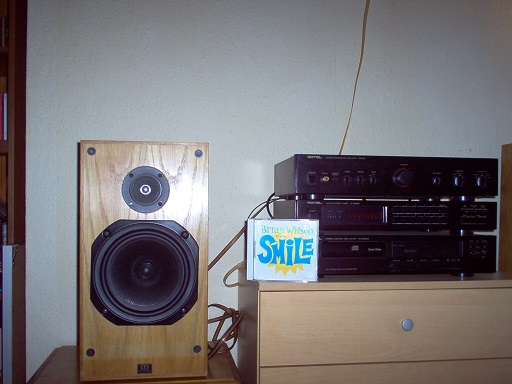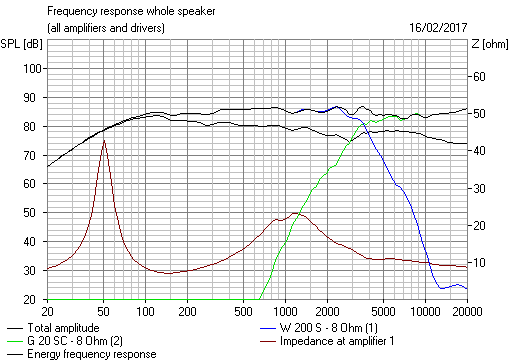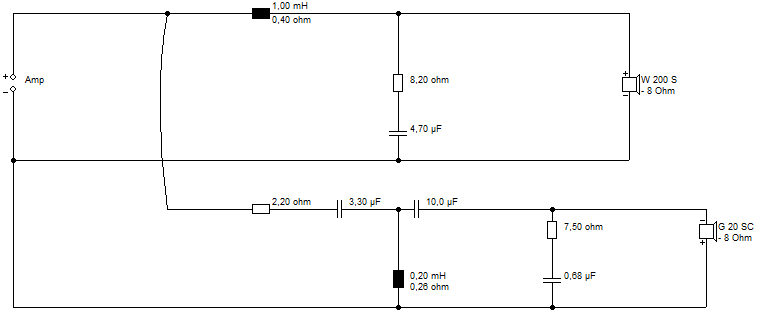From What I have read 16 ohms is best for Tube amplifiers.
...which is the result of their relative inability to supply current rather than a function of the coil resistance.
From Soundbloke;
"THD will depend primarily on the amplifier"
Surely you do not mean that, given that loudspeakers produce several magnitudes more distortion than the electronics, typically 3% at bass frequencies.
"THD will depend primarily on the amplifier"
Surely you do not mean that, given that loudspeakers produce several magnitudes more distortion than the electronics, typically 3% at bass frequencies.
From Soundbloke;
"THD will depend primarily on the amplifier"
Surely you do not mean that, given that loudspeakers produce several magnitudes more distortion than the electronics, typically 3% at bass frequencies.
I do surely not mean that as you have interpreted! My apologies for my poor use of language. I meant that the additional THD will depend primarily on the amplifier. Thank you for the correction.
As a further source of confusion to throw into the mix and the discussion regarding Qes... Remember that voice coil heating can cause its resistance to increase by a factor of up to about two for typical source material. Under normal voltage drive, Qes (and therefore Qts) is modulated accordingly. (This does not happen in current drive where Qes is irrelevant and Qts=Qms). And although thermal modulation is not directly audible (as its time constant is too long), the change in Qts might be. The heating also leads to frequency balance errors in multi-driver loudspeakers. There is much discussion to be had about coil resistance, just not the one in this thread 🙂
Low imp drivers/speakers seems to be much more sensitive for any serie resistance then high imp drivers, will the effect of voice coil heating be more severe with low imp drivers?
No, because the maximum power transferred from an amplifier to the driver is the same in both cases, limited by the same Pmax of the driver. Voice coil DC resistance Re will rise to a value Rheat, but the ratio Rheat/Re is the same.Low imp drivers/speakers seems to be much more sensitive for any serie resistance then high imp drivers, will the effect of voice coil heating be more severe with low imp drivers?
I didn't intend to be corrective, but was dismayed.
Clarifications or corrections are always a necessary addition as far as I am concerned. Hopefully your dismay was short-lived?
Do you also edgewind voice coils with almost rectangular wire as JBL does in their professional line of speakers? Then you might perhaps tell me how this edgewinding is practically done. And then you might conclude that rectangular wire isn't fixed to the equations that you gave.And you end with a useless voice coil because now *winding length* (not wire length ) changes!
Winding length is number of turns multiplied by wire diameter
Suppose you have a 10 mm gap length and a maximum efficiency voice coil, occupying 10mm length (winding length) along the former.
Using the design you suggest:
* 1.4142x turns
* 0.707x cross section
BUT new diameter will NOT be 0.707x the former one (what you are assuming in the above equation) , it will rather be SQRT 0.707 * former diameter, some 0.84X
So new winding length will be, using my generic voice coil example:
* 1.4142 * 0.84=11.9mm
Which of course is unacceptable.
You are modifying winding length, an IMPORTANT parameter, now 20% of the coil is OUTSIDE THE GAP.
I have been correcting some inaccurate assumptions along this thread, which of course I consider written in good faith and by Technically savvy Forum members, because common design practice does not apply under the STRICT space, weight and geometry constraints present in very specialized Loudspeaker design.
Me? I design and manufacture speakers for a living, for over 40 years now (probably around 45) and suffer the absolutely opposing requirements and compromises which have to be made here.
Mind you, Physics DO apply (of course), but design must bend backwards to comply with what loudspeakers need.
Remember: I've always been talking of and referring to JBL's professional products.
Best regards!
I used to design audio amplifiers, albeit not my strong suit, since you need some very expensive measuring equipment to do it well.
Your average Class AB voltage feedback amplifier is designed to work well with your average 4-8 ohm loudspeaker.

Here an old 30W per channel Rotel RA 931 with a +/- 30V power supply. In practise, the transistors can probably handle 200W, before the horrors of low impedance and high phase factor.
When I fiddle about with speakers, I try to make an easy impedance:


No HiFi amp will struggle with that.
Now it's a fact that amplifiers should be kept within their "Safe Operating Area":
Semiconductor Safe Operating Area
Get near 4 ohms and high phase angle, and trust me, you are pushing it. It might let the smoke out. This is where the real amplifier skill is. Allowing for every nightmarish contingency.
Your average Class AB voltage feedback amplifier is designed to work well with your average 4-8 ohm loudspeaker.
Here an old 30W per channel Rotel RA 931 with a +/- 30V power supply. In practise, the transistors can probably handle 200W, before the horrors of low impedance and high phase factor.
When I fiddle about with speakers, I try to make an easy impedance:
No HiFi amp will struggle with that.
Now it's a fact that amplifiers should be kept within their "Safe Operating Area":
Semiconductor Safe Operating Area
Get near 4 ohms and high phase angle, and trust me, you are pushing it. It might let the smoke out. This is where the real amplifier skill is. Allowing for every nightmarish contingency.
Last edited:
Better, would be a good way to put it. Still not close enough to use without a transformer, but the transformer compromises change.From What I have read 16 ohms is best for Tube amplifiers.
Yes, this most probably is the main driver to wind a voice coil with (almost) rectangular wire - to increase efficiency. Anyway, as the question in this thread was about possible impacts of a speaker's impedance on it's sound, I've tried to point out that with rectangular wire it indeed is possible to build drivers of different impedances, hence different motor parameters, but without altering the other TSP's, hence without altering the speakers' performance.That is a method only of maximising the current density in the gap.
Best regards!
- Home
- Loudspeakers
- Multi-Way
- Low impedance = better sound?